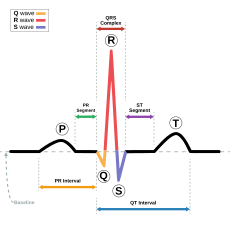Atrial fibrillation describes an irregular and often rapid heart rhythm. The irregular rhythm, or arrhythmiaarrytmia results from abnormal electrical impulses in the heart. The irregularity can be continuous, or it can come and go.
Normal heart contractions begin as an electrical impulse in the right atrium. This impulse comes from an area of the atrium called the sinoatrial (SA) or sinus node, the "natural pacemaker."
- As the impulse travels through the atrium, it produces a wave of muscle contractions. This causes the atria to contract.
- The impulse reaches the atrioventricular (AV) node in the muscle wall between the 2 ventricles. There, it pauses, giving blood from the atria time to enter the ventricles.
- The impulse then continues into the ventricles, causing ventricular contraction that pushes the blood out of the heart, completing a single heartbeat.
In a person with a normal heart rate and rhythm the heart beats 50-100 times per minute.
- If the heart beats more than 100 times per minute, the heart rate is considered fast (tachicardia
- If the heart beats less than 50 times per minute, the heart rate is considered slow (bradycardia).
In atrial fibrillation, multiple impulses travel through the atria at the same time.
- Instead of a coordinated contraction, the atrial contractions are irregular, disorganized, chaotic, and very rapid. The atria may contract at a rate of 400-600 per minute.
- These irregular impulses reach the AV node in rapid succession, but not all of them make it past the AV node. Therefore, the ventricles beat slower, often at rates of 110-180 beats per minute in an irregular rhythm.
- The resulting rapid, irregular heartbeat causes an irregular pulse and sometimes a sensation of fluttering in the chest.
Atrial fibrillation can occur in several different patterns.

No comments:
Post a Comment